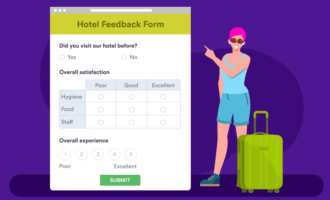What is a 1 to 5 rating scale?
- A 1 to 5 rating scale is a simple and effective way to rate the severity or magnitude of something, going from 1, the lowest rating, to 5, the highest rating, which allows respondents to answer quickly and can be applied to a variety of things.
Has your doctor ever asked you to rate your pain from 1 to 5, with 5 being the most severe? If so, you’re already familiar with rating scales. In fact, you probably encounter rating scales routinely without even realizing it.
What is a 1 to 5 rating scale?
Rating scales measure responses that aren’t easily quantified, such as feelings, perceptions, interests, and preferences. A 1 to 5 rating scale is a simple and effective way to rate the severity or magnitude of something.
It typically goes from 1, the lowest rating, to 5, the highest rating. The 1 to 5 scale allows respondents to answer quickly and can be applied to a variety of things, such as pain, temperature, and brightness.
Pro Tip
Create custom surveys — including ones with rating scales — using Jotform’s free online form builder.
Why use a 1 to 5 rating scale?
Many people prefer the 1 to 5 rating scale since it’s simple and easily understood. Rating something on a 1 to 5 scale provides a good range, from mild to severe, so that people can get an idea of how bad a problem is.
It’s also easier to compare things that have been rated on the same scale. For example, if you’re collecting feedback on a product and see a bunch of durability ratings below 2, you know you have a problem with product construction.
How to use a 1 to 5 rating scale
A 1 to 5 rating scale is a great way to collect feedback on a person’s thoughts and feelings. It can be used to rate anything, from a software application to a food item sold at a restaurant.
The first step is to create a list of questions that allow someone to rank by severity. For example, you could ask participants how easy it was to navigate your app’s main screen, and then give the following answer options:
- 1 means you didn’t enjoy it at all and would not recommend it to others.
- 2 means you didn’t enjoy it but might recommend it to others.
- 3 means you enjoyed it, but it wasn’t your favorite.
- 4 means you really enjoyed it and would recommend it to others.
- 5 means you loved it and would definitely recommend it to others.
After collecting responses from your survey, you’ll need to organize the data visually. For example, Jotform’s surveys load data into an underlying database. This database helps you quickly see all participants’ answers in one place and spot trends in user responses — helping you understand what’s working and what’s not.
Pro Tip
Create custom surveys — including ones with rating scales — using Jotform’s free online form builder.
Rating scales are common in our daily lives. Healthcare organizations use them to monitor depression, anxiety, stress, and overall well-being. Other organizations use rating scale surveys to provide better value to clients and customers. You can gain equally valuable insights by using them in your business.
Rating scale surveys help you understand your audience
Businesses use survey rating scales to gather information about satisfaction levels, frequency of use, loyalty, and other customer data. Customer response data, in turn, helps you determine which products and services are most effective. This data is essential for making informed business decisions across all departments.
Consider just one application: marketing. Successful retail stores spend between 3 and 5 percent of their sales totals on marketing. That means a business with only a few employees could spend upwards of $25,000 on marketing.
You risk wasting your small business’s funds if your marketing efforts don’t target the right audience. In contrast, using customer data to make marketing decisions gives you a huge leg up. Rating scales are a simple but effective way to learn about your customers and improve how you communicate with them. Let’s consider a few different types and how they’re used.
Different types of survey rating scales for different tasks
Rating scales range from super simple to highly complex. Each rating scale can be used to gather specific data. Here’s a list of five common rating scales and how they can be used in surveys:
- Likert scale. Participants rate their level of agreement with items that describe a topic, like customer satisfaction, usability, or loyalty. This type of survey might make a statement like “It’s important for me to use my cell phone throughout the day” and ask the participant to choose from a range of options beginning with “strongly disagree,” and ending with “strongly agree.”
- Linear numeric scale. In a linear numeric scale, participants provide a numeric response to a question or statement. This response may relate to satisfaction, ease of use, brand favorability, feature importance, or likelihood of a recommendation. You may have seen this example recently: “How likely are you to recommend our app to your friends and family?”
- Frequency scales. These scales help you understand how often or frequently people perform actions. A frequency scale question like “How often do you use your car to commute to work?” helps researchers better understand driving habits.
- Paired comparison scale. A paired comparison scale helps to discern preferences between two things, such as a website, brand, or design. For example, if you’re trying to learn about consumer brand preferences, you might show your survey group the branding for two companies and ask, “Of the two brands given, which do you prefer?”
- Pictorial/graphic scales. Instead of picking a number, participants use visuals to indicate their opinion of a particular product. This option can be helpful when participants are already used to a measurement method such as stars and thumbs-up for movie ratings.
Before deciding which method to use for your next survey, consider the different types of surveys people are already accustomed to in your industry. Your subject matter is also a significant factor.
Using a linear numeric scale in healthcare surveys may be best because people are accustomed to rating their discomfort on that scale. On the other hand, a paired comparison scale may be best for marketing since you can gain good customer insights by understanding how you stack up against the competition.
Use survey rating scales to get the data you need
Relentless market pressure is making organizations ever more data centric. The businesses that understand their audience best will beat out competition that’s complacent in their assumptions.
Learning from your audience requires skillfully asking the right questions in the right way. Although rating scales are intuitive and simple, their results are powerful indicators of what people really want from your organization.
Jotform makes it easy to survey your audience. Our online platform will help you create surveys, distribute them, and learn from the data. Try creating your first survey for free.







































































































Send Comment: